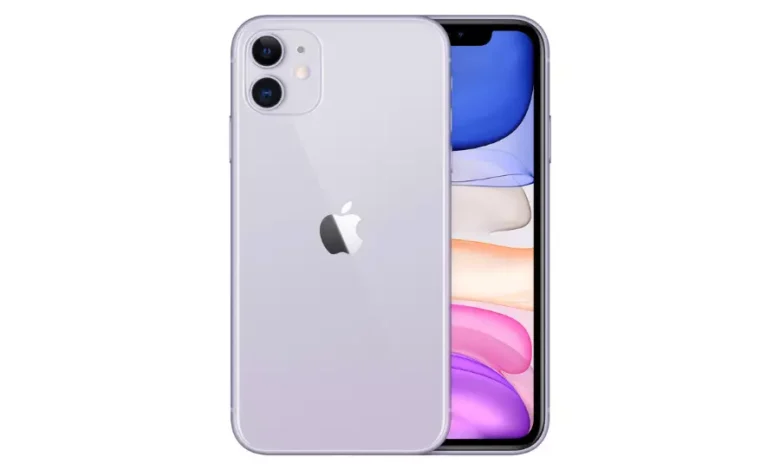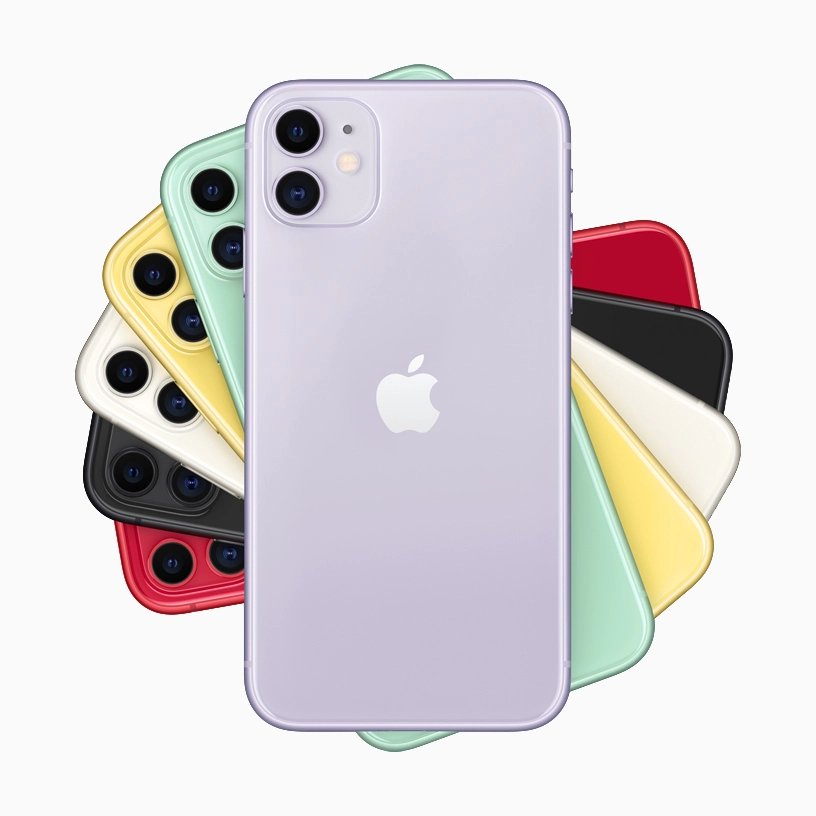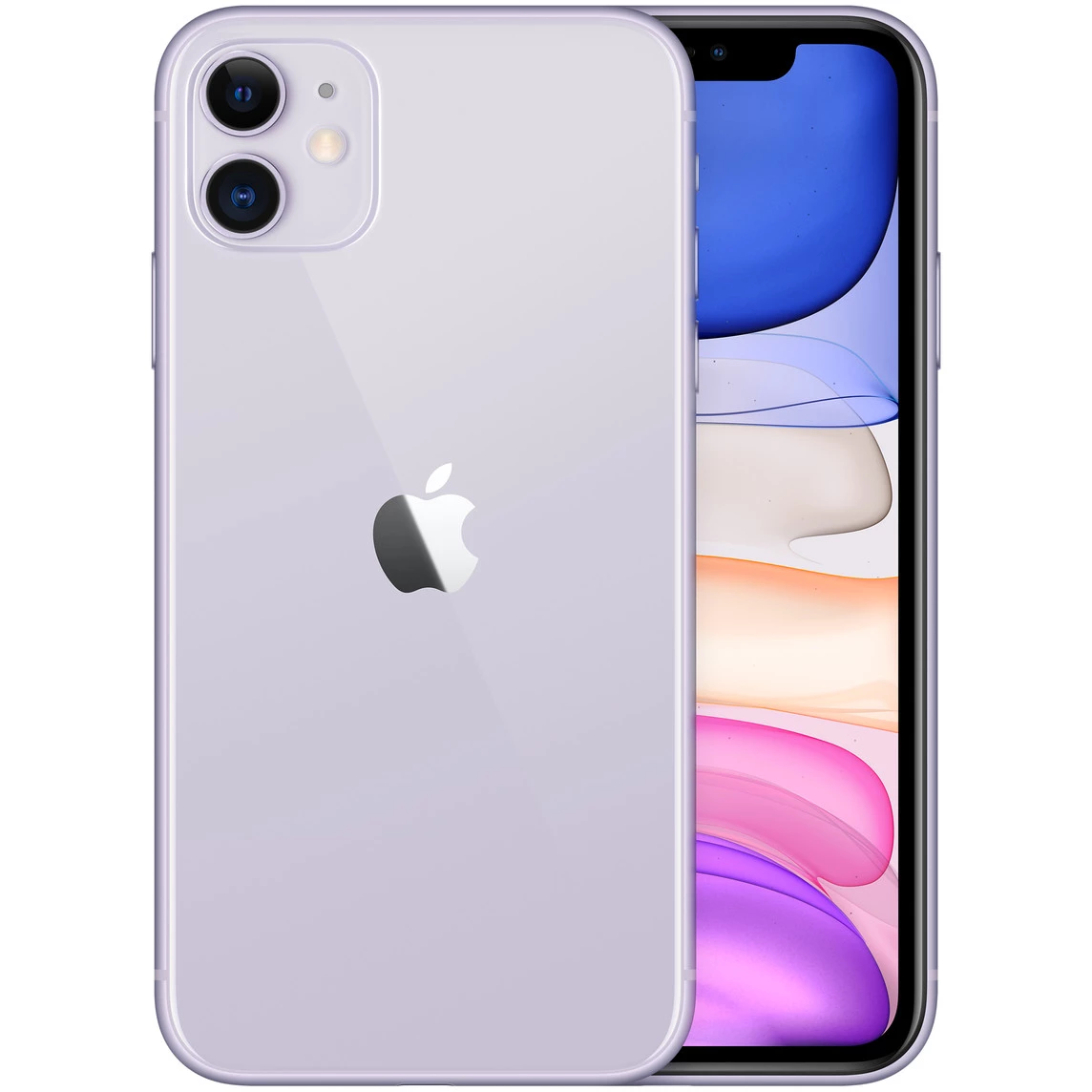

Apple iPhone 11 Full Specifications and Price in United States, Europe and United Kingdom:
| First Release | September 2019 |
| Colors | Black, Green, Yellow, Purple, Red, White |
| Connectivity | |
|---|---|
| Network | 2G, 3G, 4G |
| SIM | Nano / Electronic SIM |
| WLAN | dual-band, Wi-Fi hotspot |
| Bluetooth | v5.0, A2DP, LE |
| GPS | A-GPS, GLONASS, GALILEO, QZSS |
| Radio | ✖ |
| USB | v2.0 (USB Power Delivery 2.0) |
| OTG | Yes |
| USB Type-C | ✖ (Proprietary reversible connector) |
| Body | |
| Style | Notch |
| Material | Gorilla Glass front & back, 7000 series aluminum frame |
| Water Resistance | IP68 dust/water resistant (up to 2m for 30 mins) |
| Dimensions | 150.9 x 75.7 x 8.3 millimeters |
| Weight | 194 grams |
| Display | |
| Size | 6.1 inches |
| Resolution | 828 x 1792 pixels (326 ppi) |
| Technology | Liquid Retina IPS LCD Touchscreen |
| Protection | Scratch-resistant glass, oleophobic coating |
| Features | 625 nits, 120Hz, true-tone, wide color gamut |
| Back Camera | |
| Resolution | Dual 12+12 Megapixel |
| Features | Dual Pixel PDAF, OIS, quad-LED flash, ultrawide, HDR & more |
| Video Recording | Ultra HD (2160p), HDR, stereo sound rec. |
| Front Camera | |
| Resolution | Dual 12 Megapixel + SL 3D |
| Features | F/2.2, HDR, 23mm (wide), depth / biometrics sensor |
| Video Recording | Ultra HD (2160p), gyro-EIS |
| Battery | |
| Type and Capacity | Lithium-ion 3110 mAh (non-removable) |
| Fast Charging | 18W Fast Charging (50% in 30 min), Qi Wireless Charging USB Power Delivery 2.0 |
| Performance | |
| Operating System | iOS 13, upgradable to iOS 13.4 |
| Chipset | Apple A13 Bionic (7 nm+) |
| RAM | 4 GB |
| Processor | Hexa-core, up to 2.65 GHz |
| GPU | Apple GPU (4-core graphics) |
| Storage | |
| ROM | 64 / 128 / 256 GB (NVMe) |
| External Slot | ✖ |
| Sound | |
| 3.5mm Jack | ✖ |
| Features | Loudspeaker (stereo speakers) |
| Security | |
| Fingerprint | ✖ |
| Face Unlock | Apple Face ID |
| Others | |
| Notification Light | LED Flash for Alerts |
| Sensors | Face ID, Accelerometer, Proximity, Gyroscope, E-Compass, Barometer |
| Manufactured by | Apple |
| Other Features | Apple Pay (Visa, MasterCard, AMEX certified), Siri, Qi wireless charging |
Apple iPhone 11 Price in United States, Europe and United Kingdom:
| United States | $ 499.00 |
| Europe | € 546.00 |
| United Kingdom | £ 489.00 |

Apple iPhone 11 is a cutting-edge smartphone designed to provide users with an exceptional mobile experience. With its powerful A13 Bionic chip and 64-bit architecture, this device delivers lightning-fast performance and seamless functionality. Apple iPhone 11 features a stunning 6.1-inch Liquid Retina HD display, offering vibrant colours and crisp visuals that make watching movies, playing games, and browsing the web a true delight.
Apple iPhone 11 also boasts an impressive dual-camera system, comprising a 12MP main camera and a 12MP ultra-wide-angle camera. This setup allows users to capture breathtaking photos and videos with unparalleled detail and width. And with advanced features like night mode, portrait mode, and video recording in 4K at 60fps, users can elevate their photography skills to new heights.
Apple iPhone 11 comes equipped with a long-lasting battery that provides up to 10 hours of internet use on a single charge. This means users can enjoy their favourite shows, music, and apps without worrying about running out of power throughout the day. The device also supports wireless charging, making it easy to recharge on the go.
Apple iPhone 11 is a game-changing smartphone that sets a new standard for mobile devices. Its blend of speed, style, and innovative features makes it an essential tool for anyone who wants to stay connected and captivated on the go.
Disclaimer: We can not guarantee that the information on this page is 100% correct. Read more
FAQ:
- Display: The screen display is one of the most important parts of a smartphone. It shows the user interface, apps, photos, videos, and other visual content. Displays come in different sizes, resolutions, and technologies such as LCD, OLED, AMOLED, and Retina.
- Processor: The processor is the brain of a smartphone. It handles all the calculations, operations, and tasks that the phone performs. Popular smartphone processors include Qualcomm Snapdragon, Apple A-series, and Huawei Kirin.
- RAM (Random Access Memory): RAM temporarily stores data and applications that the processor uses. More RAM means faster performance, smoother multitasking, and better gaming experience. Most smartphones have at least 4GB of RAM, but some high-end models offer up to 16GB or more.
- Storage: Smartphones have internal storage where the operating system, apps, photos, videos, and other files are stored. Some phones also have expandable storage via microSD cards. Common storage capacities range from 16GB to 512GB.
- Camera: Smartphone cameras have improved significantly over the years, offering advanced features like optical zoom, portrait mode, night mode, and video recording in 4K or higher resolution. Front cameras are typically used for selfies and face recognition.
- Battery: The battery life of a smartphone depends on various factors like screen size, processor, usage patterns, and software optimization. Many smartphones now support fast charging, wireless charging, or both. Battery capacities usually range between 2000mAh and 5000mAh.
- Operating System: The operating system manages the hardware and software resources of a smartphone. Popular smartphone OSes include Android, iOS, and Windows. Each has its unique features, app ecosystem, and user interface.
- Connectivity: Smartphones often feature multiple connectivity options like Wi-Fi, Bluetooth, NFC, GPS, and cellular networks (e.g., 4G, 5G). These allow users to access the internet, pair devices, navigate, and communicate with others.
- Audio: Smartphones may have speakers, earpieces, or headphones for audio output. Some phones also have specialized audio chipsets for enhanced sound quality or noise cancellation.
- Sensors: Various sensors inside smartphones enable features like fingerprint scanning, facial recognition, accelerometer, gyroscope, proximity detection, and ambient light measurement. These enhance user experience, security, and functionality.
- Durability: Smartphones are made with materials like glass, metal, or plastic. Some phones have IP ratings for dust and water resistance, which protect against accidental exposure to liquids or solid particles.
- Charging port: Smartphones require charging ports to replenish their batteries. Common charging ports include USB-C, Lightning (for iPhones), and Micro-USB (less common nowadays). Wireless charging pads or stands eliminate the need for cables.
- Buttons and controls: Physical buttons and touch controls facilitate navigation and operation. Common buttons include power, volume, and camera shutter release. Some phones use on-screen navigation keys or gesture-based interfaces.
- Antennas: Smartphones contain antennas for cellular communication, GPS, and Wi-Fi. They may be located at the top or bottom edges, or integrated into the device’s body.
- Fingerprint reader: Many smartphones feature fingerprint readers for biometric authentication. These can be physical buttons or optical scanners embedded under the display. Face ID systems are also becoming popular alternatives.